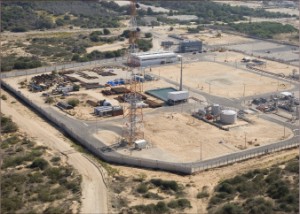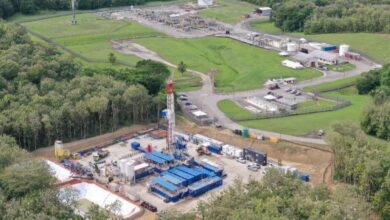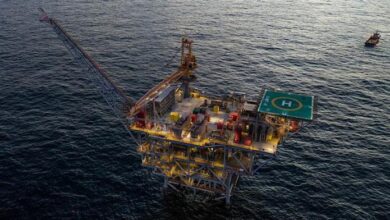Managing exploration risks with trained intuition
Critical D&C issues with Susan Cunningham, Noble Energy
By Linda Hsieh, assistant managing editor
Susan Cunningham is senior vice president of exploration for Noble Energy.

DC: As someone responsible for assessing and determining potential exploration targets that require millions of dollars to drill, what is your view of risk management?
Cunningham: Risk management is what we do all the time, just by definition with exploration. My view of risk management is that it’s a disciplined process, and you can’t go by gut feeling. Gut feel is the road to perdition. A great example is what happened in the US economy – that was all about people not managing risk properly. The discipline was lost. Risk management means having a disciplined process to understand the risks, then make good decisions.
DC: You made a presentation to the Drilling Engineering Association at its annual workshop in August 2009 in which you advocated the use of intuition in exploration. How does that fit into your view of risk management?
Cunningham: Intuition isn’t gut feel. I define intuition as trained experience based on what has worked and not worked in the past. That’s helpful intuition.

Let me explain it this way: For athletes who are at the top of their game in various sports, what is it that makes them able to consistently perform so well? Studies have been done showing that the athletes who are at the top of their game are always looking at the results of their performance. They’re always looking back and saying, “I should have made that pass better. What did I do that was right on this one? What did I do that was wrong on this one?” They’re always evaluating their performance, doing what we call postmortems.
With trained intuition, the brain is constantly looking at and evaluating what works. From an exploration perspective, we look at every well drilled, successes and failures, and look at what worked and what didn’t so you get a better sense of the risk. When an athlete is actually in a game, they don’t have the time to do the analysis. The brain is already trained, and the emotion says this feels right to throw the ball to that person now. When I talk about intuition, it’s only the trained brain that adds value.
DC: So this is an intuition you can train your employees to have?
Cunningham: Absolutely. If you have a process so that the teams are learning from all their exploration failures, that’s the training.
DC: From that perspective, it seems like maybe failing isn’t necessarily a bad thing.
Cunningham: Human beings actually do the best learning when they fail. That’s why people tend to grow from experiencing hardships and failures. To me, if a company is successful all the time, they’re going to fail because they’re not learning. It’s not sustainable unless you have a process that helps you focus on learnings. And when you’re successful, it’s easy to get lazy.
It’s all about making sure you have a disciplined process to never get lazy. Never allow complacency.
DC: Other than risk management, what are the critical issues you spend your time dealing with?
Cunningham: Ensuring that Noble has the competitive technologies on the geoscience and exploration side and the appropriate technologies for the types of projects we have. That we have talented people and keep them trained. That we have processes to translate all the technical interpretation into numbers that are meaningful for our portfolio of investment opportunities from a value-add perspective. That we have the right processes to then decide which are the right ones to invest in.
DC: So what advances in the geosciences are you’re looking for?
Cunningham: On the seismic side, it’s always going to be the emerging technologies and advances that can help us understand imaging in complex terrains, through seismic as well as in understanding the rock properties – the rock properties of the rock and the rock properties of what’s in the pores of the rock.
Advances are also being made in terms of tectonics and the impact on rocks, like salt movement, depositional systems, as well as geochemical modeling, understanding pore pressure and understanding geochemical changes in the subsurface.
DC: What are the gaps between what you’d like to achieve and the technologies that are available to you in seismic or imaging?

Cunningham: I always have a hard time with questions like that. What we’d all like to achieve is to have all the answers – to see everything. But that’s just not realistic.
It’s hard to predict what future technologies will be, but the ones that help the business from my perspective fall in two categories. One is the IT-type technologies, which is how we work together across the globe. Things that enable virtual collaborations between disciplines around the world, whether it’s from the rig site to the office or people located in different offices. Then it’s the technologies specific to our industry in geology, geophysics, drilling, completion and production.
I have a hard time answering because who knows where the future will lead? We’re always trying to improve our understanding of the different elements that go into an exploration decision and how we make our decisions and understanding risks. Anything that helps us understand source, presence and maturity, migration, as well as reservoir characteristics, field characteristics and trap characteristics.
DC: Where are Noble’s focus areas as far as exploration?
Cunningham: Our focus areas are the deepwater Gulf of Mexico, predominantly subsalt, as well as West Africa and the eastern Mediterranean. We also have tight gas plays onshore US in the Rockies, Midcontinent area.
DC: In the Gulf of Mexico, what are the challenges you’re dealing with in imaging the subsalt?
Cunningham: Most of the rock property work like bright spots and amplitudes work in the shallower, above-salt setting, but they don’t tend to help you out below salt. Salt disperses the energy so much from the seismic waves, making it hard to interpret. The huge resurgence in significantly sized discoveries in deepwater Gulf of Mexico is all because of imaging technology improvements.
DC: What kinds of improvements?
Cunningham: Things like wide azimuth seismic acquisition and reverse time migration technologies.
DC: As technologies improve, such as with wide azimuth as you mention, are you finding yourself having to deal with an increasingly significant amount of data?
Cunningham: Yes, dramatically. Therefore the next technology we need is being able to manage all that data. That’s all about algorithms, computing, capacity, etc. Computing capacity is increasing, which allows the technologies to acquire more data, and more data means more precision. But it’s also important how you manage it and make your decisions.
DC: You also mentioned doing work in the US shales. What are your challenges there?
Cunningham: It’s a different understanding of rock properties than for conventional plays. It also translates very quickly to completion strategy and technologies.

In these shale plays, you’re basically getting the hydrocarbons from the source rock, not waiting for it to migrate into a higher-permeability reservoir rock. And, really, rather than shales, I would just call it tight rock. I think we’re discovering that shale plays are really not shales – they’re just shaly sands or shaly carbonates.
DC: So we’ve been able to produce hydrocarbons from them because they’re not true shales?
Cunningham: Correct. It’s a continuum. There’s shale that’s like clay… the gumbo stuff. We’re not producing from that. What we’re producing from has just enough small grains of sand or carbonate to give it some porosity or permeability. People still call them shales because they’re predominantly shales, but there’s a continuum.
I don’t think the industry is producing from anything that’s 100% shale.
DC: Has development of tight rock resources in the US led to similar exploration opportunities in other regions around the world?
Cunningham: Sure, it’s not like these rocks exist only in the US, and it’s already starting to happen. People are lifting their heads and looking at where else in the world this might work. It is something on Noble’s radar screen as well.
DC: Overall, what do you think are the most critical challenges facing the drilling and completion industry today?
Cunningham: You’ve probably heard it ad nauseam, but it’s going to be safety, efficiency, cost and environment. When activity levels went up (in the previous boom), safety statistics got worse because so many new people were coming in and there was not enough time to train people properly. We have to keep safety number one. Then, efficiency and cost are related because if you’ve got high efficiency, the cost should go down.
Environment is also important and becoming more important everyday. We have to be really cognizant of our impact on the communities we’re working in, and that’s a big challenge. We have to really think about what we’re doing in the environments where we operate. If we don’t pay any attention to that, the situation will become more adversarial than it is.
Water is also an important challenge, especially with water being used more and more in the tight plays. It’s already becoming an issue and will become more significant as the population in the world continues to increase. We really have to work on that.




